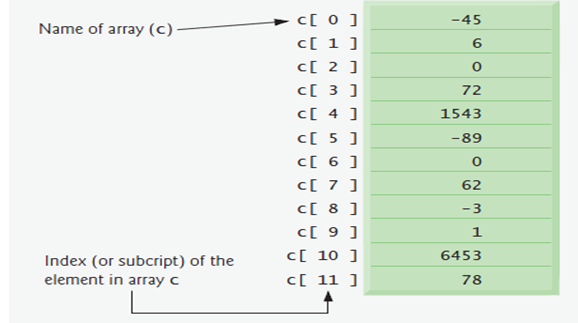1. An array is a group of
variables that have a common name.
2. An array is an abstract
data type.
3. Arrays are stored in
contiguous memory locations.
4. They are fixed length
entities i.e. they remain the same once they are created.
5. Arrays of any type can
have one or more than one dimensions.
6. The element of an array
can be accessed by its index also known as subscript.
7. With the help of arrays we
can group related information.
8. Array is a collection of
homogeneous elements with same name.
Example:
1. The array name is c.
2. The elements in the array
are referred to as c [0], c [1], to c [11]. This means 12 elements from 0-11.
Creating an
array:
In Java arrays are implemented as
objects.
In order to create an array we must
first declare an array and then instantiate it using new operator.
Declaring/Instantiating
an array:
|
int c[] = new int[12];
|
This declaration and array creation
create an array containing 12 int elements and store the reference in variable
c.
The task can
be performed in two steps:
int
c []; //declare the
array variable
c
= new int [12]; //create the array;
assign to array variable
float [] salary = new float [100];
1. A salary is an array
variable which stores the reference to the array which contains 100 float type
values.
2. The default values for an
array of numeric elements are 0. For Boolean arrays are false. For char arrays
are ‘\u0000’ (space). For an array of class type are null.
Initializing
arrays:
Once an array is created, each
element of an array is set to its default initial value according to its type.
User can also provide value other
than the default value by using array initialization.
|
data type [] array name = {value1,
value2 …};
|
|
int [] num = {5,10,15,20};
|
The above initialization
is also equivalent:
int [] num = new int [5];
num [0] = 5;
num [1] = 10;
num [2] = 15;
num [3] = 20;
num [4] = 25;
How to get
length of an array:
1. The user can access the
length of an array i.e. the number of elements it holds.
2. By using its length field
which is public and final implicitly.
3. The length field is
associated with each and every array which has been instantiated.
4. Length field can be
directly accessed using the array name and a dot operator because it is a
public member.
|
num.length; //to access the number of elements in an
array called num.
|
1. Array with length zero is
said to be an empty array.
2. Length field of an array
can also be used to control the numerical for loop which iterates over the
elements of an array.
One
dimensional array: They are a list of like-typed variables which have only one
index or subscript.
Multidimensional
array: Arrays of Arrays
1. These are the arrays which
contain more than one index and can be stored in more than multiple dimensions.
2. The information is
arranged in rows and columns.
3. But Java does not directly
support multidimensional arrays.
Two
dimensional arrays: these arrays require two indexes to identify a particular
element.
Left
index refer to rows.
|
[0][0]
|
[0][1]
|
[0][2]
|
[0][3]
|
[0][4]
|
|
[1][0]
|
[1][1]
|
[1][2]
|
[1][3]
|
[1][4]
|
|
[2][0]
|
[2][1]
|
[2][2]
|
[2][3]
|
[2][4]
|
|
[3][0]
|
[3][1]
|
[3][2]
|
[3][3]
|
[3][4]
|
Right index refers to columns.
int two [] [] = new int [4] [5];
This allocates a 4 by 5 two
dimensional array and this matrix is implemented as an array of arrays of int.





